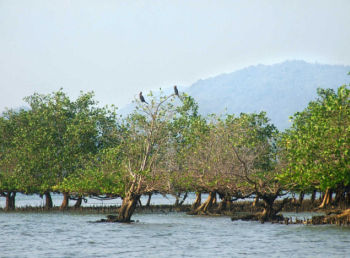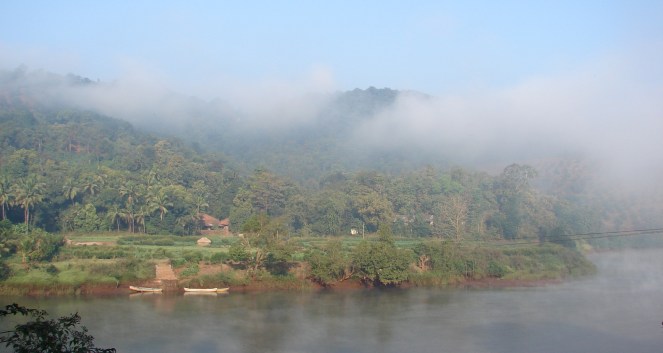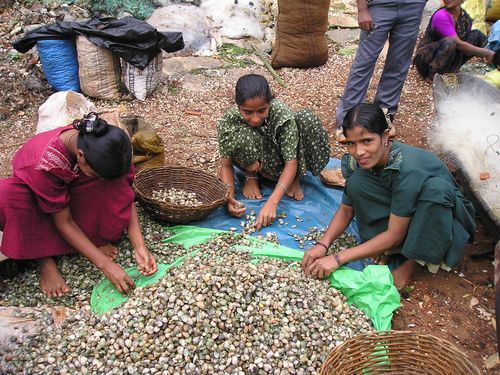Comparing ecological goods and services of a dammed Vs undammed river estuary is important for a number of reasons. This sort of post facto analysis is seldom done in our country. That is why a case study by Mahima Bhat, V. N. Nayak et al (Mahima Bhat, 2012) comparing Aghanashini and Sharvathi estuaries titled “Impact of Hydroelectric Dams on Fisheries in the Sharavathi Estuary of Uttara Kannada District, South-West India” is an important study (http://www.ces.iisc.ernet.in/energy/lake2012/fullpaper/mahima_fullpaper.pdf). The researchers are a part of Wetlands and Energy Group of the Centre for Ecological Science, Indian Institute of Sciences, Bangalore. The study went on for one year in which the researchers studied and compared productivity, ecological goods and services and fish diversity of Aghanashini and Sharavathi Estuaries. They have talked with the fisher folk and listened to what they had to say about impacts of dams on Sharavathi on the fish catch and productivity of the Sharavathi estuary.

Due to a number of peoples protests supported by some well-researched studies by Centre for Ecological Sciences, IISc, Aghanashini River, small west flowing river of the Western Ghats is as yet in a free flowing, undammed condition. The stretches river also has recently been declared conservation reserve. In many senses, West-flowing River basins of Western Ghats in Karnataka have set inspiring examples. Plans of building a hydel dam on BedthiRiver, also in coastal Karnataka were dropped due to extensive studies and advocacy of groups which demonstrated that the river is of higher value than the dam. (Read Vijay Paranjpye’s book on the subject: Foresight at Bedthi)
Free flowing rivers are the rivers which do not have any dams or barrages on their course. In its dam onslaught, India has few free flowing rivers left. We do not have any policy or law to protect these last remaining free flowing rivers. Many countries across the world have specific laws to protect free flowing rivers that they have. To know more about free flowing rivers and policy tools across the world to protect these, see: http://www.internationalrivers.org/resources/where-rivers-run-free-1670
Western Ghats has few free flowing rivers like Shastri (Ratnagiri district of Maharashtra) and Aghanashini (Uttar Kannada district of Karnataka). The range of services provided by these rivers is often neglected. In reality, they support livelihoods of communities around them as well as rich biodiversity. Studies indicate that free flowing rivers are more resilient to challenges posed by Climate Change than their dammed counterparts.

The paper tries to evaluate the ecological as well as economic status of Aghanashini/ Tadri river estuary and that of Sharavathi Estuary. River Sharavathi has cascade of hydel dams on its main stem and tributaries, most of them belonging to the Karnataka Power Corporation Limited, together with an installed capacity of 1469.2 MW (for a map of the basin with HEP locations, see: https://sandrp.in/basin_maps/Sharavathy150411.jpg). The dam that is closest to the estuary is the Gerusouppa HEP (240 MW), the dam that is farthest is Linganamakki (55 MW).
Table 1Flow Chart of 1469.2 MW Sharavathi Hydroelectric Projects Source: KPCL

These dams submerged a huge area of land, forests and villages. Linganmakki Dam submerged 326.34 sq km, Talakalele: 7.77sq km and Gerusoppa submerged 5.96 sq. km respectively. The Linganamakki reservoir resulted in the full or partial submergence of 99 villages in the Sagar and 76 villages in the Hosanagar taluks of Shimoga district, also causing the displacement of 12000 people. The Talakalale reservoir resulted in the full or partial submergence of 3 villages in the Sagar taluk. Whereas, the Gerusoppa reservoir the submerged 5.96 sq. km of tropical evergreen to semi-evergreen forests. In addition, for the Sharavathi Tail Race project, 4.72 sq. km of forest and 0.08 sq. km of other lands was also acquired for the township, roads, etc. (http://www.ces.iisc.ernet.in/energy/water/paper/Cumulative/studyarea.htm) The land taken for Chakra dam, Savehaklu dam (both upstream of Linkanmakki dam) and Kargal Anicut and Sirur balancing reservoir would be additional.

The dams have no system of releasing environmental flows, mimicking the natural hydrograph of the river for people and communities in the downstream.
Geographically the Uttar Kannada district of Karnataka has 4 estuaries. From north to south, these are Kali, Bedthi/ Gangavali, Aghanashini/ Tadri and Sharavathi estuaries. Distance between Kali and Bedthi estuary is 32 km, just 10 km further south, we have Aghanashini/ Tadri estuary and further 24km south we have Sharavathi estuary.


Important findings of the study:
Please note that the comparison given below is only with respect to some specific aspects of estuaries of the two river basins and not with respect to the whole river basins and cost benefits of the hydropower projects in case of Sharavathi basin. The implied impacts mentioned here on the Sharavathi basin is not with respect to what was the situation before the projects were taken up. It needs to be added that such impacts were not taken into account while taking decisions about the projects, while doing cost benefit analysis of the projects, while undertaking social and environmental impact assessments or while formulating social and environmental management plans.
1. Free flowing river supports more biodiversity:
90 fish species were observed in Aghanashini estuary while the number of different fish species observed in Sharavathi estuary is only 43, nearly 50% less than Aghanashini. Sharavathi had specifically lower populations of marine species migrating up river. This is attributed to near-freshwater salinity of Sharavathi Estuary, maintained due to constant inflow of water from upstream hydel projects, even in peak summer.
2. Free flowing River supports more river dependant livelihoods, than its dammed counterpart
Aghanashini Estuary supports 20 fishing villages, while there are only 10 fishing villages in Sharavathi Estuary. Fisherfolk in Aghanashini are more than 6000, while Sharavathi estuary supports only 283 fisherfolk. Gathering of edible bivalves, a major economic activity in Aghanashini estuary has gone extinct in Sharavathi.
3. Estuarine salinity is highly modified in the river with hydel projects:
Aghanashini’s salinity increases during non-monsoon months – since it is a rain-fed river. This salinity makes conditions favorable for marine fish and other animals to travel upstream the estuary. The salinity of the Aghanashini reaches the peak value of 24-34 ppt[1] during April- May.
Sharvathi: the study finds that even in peak summer months, the salinity of Sharavathi Estuary remains under 1 ppt, due to the continuous release of dammed freshwater from the turbines into the river while producing power. Hydropower projects affect the hydrograph as well as salinity in a river. Due to this drastic change in salinity, only the organisms which have a high tolerance for freshwater are found in Sharavathi estuary. Fishes and estuarine organisms such as crabs, bivalves etc. have a specific range of tolerance towards salinity. These freshwater conditions affect the species of fish that migrate upstream in the Sharavathi estuary.
4. Estuary of a Free flowing river is highly productive in ecological terms than its dammed counter part
The open estuarine part of Aghanashini, measuring 1977 ha, excluding saltpans, rice, and aquaculture, has annual fisheries (including bivalves) income to the tune of estimated Rs 1,095,072,000 or about Rs 1095 million, at Rs 553,905/ ha, in Sharavathi, 977 ha of open estuary produces only Rs 12,852,500 income or Rs 12.85 million, at an abysmally low rate of Rs 13,155/ ha in comparison. Shrimp aquaculture is widespread in Aghanashini, while practically non-existent in Sharavathi.
The study recommends exercising caution in “execution of hydroelectric projects in the west flowing rivers from Western Ghats to avoid fisheries collapse and dislocations in local livelihoods and economy.”
The study mainly attributes fall in fisheries to salinity changes in Sharavathi following cascade of dams. There may be other major underlying reasons contributing to this, including change in entire hydrological regime of the river and estuary, which affects fisheries, change in sediment load, sediment trapping by upstream dams, blockage to upstream and downstream migration of fish, pollution, differing and changing water use pattern, including groundwater uses, etc. The study mentions some of these reasons, although it’s done rather sketchily. There needs to be more thorough analysis of these factors.
In conclusion Value of a river is not only limited to the hydropower it can produce. Rivers have been providing free and invualble services to communities and societies at large since time immemorial. These services cannot always be converted into monitory terms, due to their complex and interconnected nature. At times, it is also not advisable to attempt that. However it is high time that free flowing rivers are at least recognized as important repositories of biodiversity and as highly useful ecosystems from anthropogenic view, offering goods and services for free, in addition to providing habitat for aquatic and terrestrial biodiversity.
Unfortunately, India’s environmental impact assessments, costs and benefit analysis surrounding dams and hydel projects do not give any value to a flowing river. The value of a river is assumed to be zero! The social impact assessment also needs to take into account the impact of the project on livelihoods of the people dependent on downstream river and rehabilitation plans needs to take such impacts into account. None of this is happening today.
There is an urgent need of a policy to protect the last remaining free flowing rivers in our country and understand the range of goods and services such Rivers can provide to communities and ecosystems currently and in future with changing climate.

About Wetlands and Energy Group, CES, IISC: Wetlands and Energy Group of the IISc, currently under the leadership of Dr. T.V. Ramchandra has been working on groundbreaking research which is connected to the real challenges faced by regions like Western Ghats. When the gap between research and challenges faced by biodiversity on the ground is widening day by day, such research by IISc is indeed laudable.
Their initial study on Aghanashini Estuary: http://wgbis.ces.iisc.ernet.in/biodiversity/pubs/ETR/ETR35/ETR35.pdf
On impacts of Gundia Hydel Project: http://www.ces.iisc.ernet.in/biodiversity/pubs/ces_tr/TR122/introduction.htm
On Cumulative Impact Assessment of Sharavathi projects: http://wgbis.ces.iisc.ernet.in/energy/sharavathi/svati.htm
On impacts of Kukke I and Kukke II Hydel projects: http://wgbis.ces.iisc.ernet.in/biodiversity/pubs/ETR/ETR54/intervention.htm
-Parineeta Dandekar, Damodar Pujari
[1] Parts per trillion: 1 ppt= 10-12
